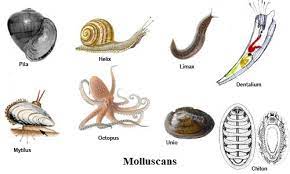Phylum Mollusca
Molluscs are a diverse group of organisms that play a vital role in the global ecology. A calciferous shell is found on many creatures in this phylum. The bodies are usually soft and protected by a hard exoskeleton. They can be found both on land and in the deepest parts of the ocean. This is the second-largest phylum of animals. Molluscs are organ-system-organized terrestrial or aquatic (marine or freshwater) animals. They are animals that are bilaterally symmetrical, triploblastic, and coelomate. A calcareous shell covers the body, which is unsegmented with a distinct head, muscular foot, and visceral hump. Over the visceral hump, a soft and spongy layer of skin forms a mantle.The mantle cavity is the region between the hump and the mantle, and it contains feather-like gills. They have breathing and excretory systems. Sensory tentacles can be found in the anterior head region. The radula, a file-like rasping organ in the mouth, is used for feeding. They are both a food and a jewellery source. The firm shells are used to create stunning jewellery. Even though it sounds strange, these are also raised as pets in some parts of the world. Bivalve and gastropod pearls are particularly valuable because they are lined with nacre. Natural pearls are generated when a small foreign object becomes lodged between the mollusc's mantle and shell.Bivalve molluscs are useful as freshwater and marine bioindicators. However, not all molluscs are beneficial to humans. Snails and slugs, for example, are considered pests.They are usually dioecious and oviparous with indirect development. Examples: Pila (Apple snail), Pinctada (Pearl oyster), Sepia (Cuttlefish), Loligo (Squid), Octopus (Devilfish), Aplysia (Seahare), Dentalium (Tusk shell), and Chaetopleura (Chiton).


 ACME SMART PUBLICATION
ACME SMART PUBLICATION
